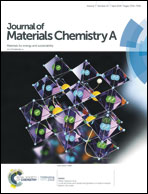Multipurpose [1,2,4]triazolo[4,3-b][1,2,4,5] tetrazine-based energetic materials†
Abstract
Two series of [1,2,4]triazolo[4,3-b][1,2,4,5]tetrazine-based energetic materials were synthesized effectively by using monosubstituted tetrazine or tetrazine-based fused rings as starting materials. Among them, compound 5 exhibits excellent insensitivity toward external stimuli (IS = 43 J and FS > 360 N) and a very good calculated detonation performance (Dv = 9408 m s−1 and P = 37.8 GPa) that are comparable to the current secondary-explosive benchmark, CL-20, which strongly suggests 5 as a secondary explosive. The azo compound 10 has a remarkable measured density of 1.91 g cm−3 at 20 °C, excellent thermal stability (Td = 305 °C), and very good calculated detonation performance (Dv = 9200 m s−1 and P = 34.8 GPa), which outperforms all current heat-resistant explosives. Compound 10 has a significant potential as a heat-resistant explosive. Compounds 14, 17 and 19 are very sensitive (IS ≤ 2 J and FS ≤ 100 J) but exhibit excellent calculated detonation performance (Dv ≥ 8690 m s−1 and P ≥ 30.2 GPa) which are very high values among current azide-containing primary explosives. These attractive features suggest strong possibilities for applications as primary explosives. A detailed study based on X-ray diffraction is used to illustrate the relationship between weak interactions and sensitivity of energetic materials. Attempts were made to design next-generation fused ring energetic materials for different applications as an alternating kind or site of the substituent group(s).
![Graphical abstract: Multipurpose [1,2,4]triazolo[4,3-b][1,2,4,5] tetrazine-based energetic materials](/en/Image/Get?imageInfo.ImageType=GA&imageInfo.ImageIdentifier.ManuscriptID=C9TA01717H&imageInfo.ImageIdentifier.Year=2019)
- This article is part of the themed collections: 10th Anniversary: Dedicated Authors and 2019 Journal of Materials Chemistry A Most Popular Articles


 Please wait while we load your content...
Please wait while we load your content...
